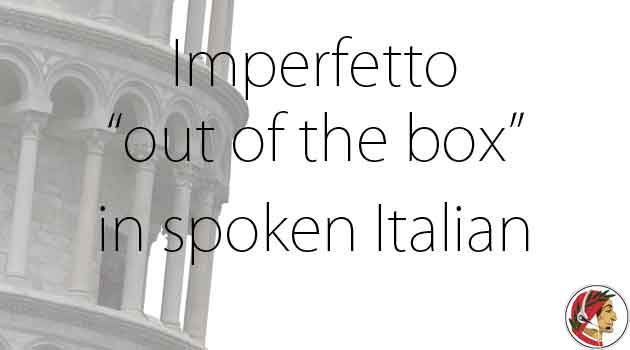The “conversational” use of the imperfetto in Italian is very common and helps to simplify the language. Is it right to learn it the wrong way?
I’m not going to explain again the correct use of the imperfetto, but how the “incorrect” and common use of it, is so popular in the spoken language.
The imperfetto, “imperfect” by definition, is very flexible and can break some rules.
There are many ways we can use it as an alternative to more complex structures. For example:
Imperfetto ipotetico
The Italian condizionale and congiuntivo are elegant, beautiful tenses, and make the Italian language so musical. They are combined together to build conditional sentences. For example:
- Se studiassi tutti i giorni, imparerei l’italiano
It means that if “I studied every day, I would learn Italian”: Congiuntivo imperfetto and Condizionale presente. This is the correct way to build the periodo ipotetico della possibilità, a possibility that may occur now or in the future: the Italian and English second conditional.
Things may change if I want to use the third conditional:
-
Se avessi studiato tutti i giorni, avrei imparato l’italiano.
If I had studied every day, I would have learned Italian. So it’s impossible now, it was possible in the past. Congiuntivo trapassato and condizionale passato.
This last example can be easily simplified in spoken Italian with
-
Se studiavo tutti i giorni, imparavo l’italiano
This is poor grammar, sloppy, and you should learn the correct conditional sentences. As a matter of fact though, some people use the imperfetto indicativo instead of the condizionale passato and the congiuntivo.
We have to find some balance between following rules and be flexible when needed, so I think that every intermediate and advanced student should learn the “wrong” imperfetto. But we’ll get back to that at the end of this article.
Imperfetto di cortesia
In this second typology, the flexibility of the imperfetto is very useful when we need to soften the tone of a request. The verb volere (want) sounds too direct with the presente indicativo:
-
voglio un caffè e un panino al prosciutto
The waiter will bring you a coffee and a ham sandwich, but you were quite rude: “I want” is way too direct.
-
vorrei un caffè e un panino al prosciutto
This is perfect. The condizionale makes the request possible and not imperative.
-
volevo un caffè e un panino al prosciutto
“I wanted” a coffee and a ham sandwich. “I wanted” now, not in the past. It’s illogical but in this case the imperfetto is a valid alternative to the presente and condizionale.
Imperfetto as possibility in the future
The imperfetto is a past tense, but in some cases we can use it to talk about intentions and possibilities in the near future. Some examples:
- Domani volevi andare in palestra?
- Ho sentito che stasera c’era un bel film in tivù.
- Ti ricordi a che ora partiva l’aereo domani?
All the sentences above are conversational and sound just right to Italian speakers. Italians use the imperfetto here without paying much attention to the fact we’re talking about the future using a past tense.
This is possible because all these events are linked to previous knowledge. In other words, the speaker is resuming a past discussion and the imperfetto refers to it, not necessarily to the event.
The conclusion, and my point of view, is the following.
We can talk about an “unorthodox” use of the imperfetto, but not of new trend or a sudden change of the Italian language. “Modal imperfetto” has been around for centuries in literature, from Dante to modern and contemporary authors, and all the cases are encoded in the Italian grammar.
In Italian we say parla come mangi, “speak the same way you eat”, keep it simple. So, use the condizionale when you need to be correct, let yourself go and allow some imperfetto when your teacher is not around.
Alla prossima!


